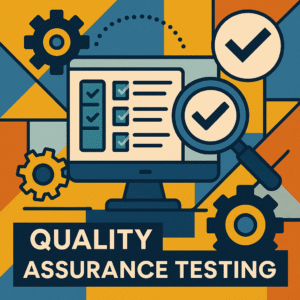Improving SaaS Application Testing through Codeless Test Automation
I. Introduction
As the adoption of SaaS (Software as a Service) applications surges among companies, testing these applications becomes indispensable. While manual testing is labor-intensive and susceptible to errors, automation facilitates quicker and more precise testing. However, conventional automation tools necessitate scripting expertise, making them challenging to employ for those without coding knowledge. Codeless test automation tools, on the other hand, are revolutionizing this domain by offering a more accessible and intuitive approach to automated testing, empowering even the non-technical team members to contribute efficiently.
This article delves into the advantages of employing codeless test automation tools in enhancing the quality and efficiency of your SaaS application testing, examining their features, functionalities, and ease of use.
What is SaaS Application Testing?
SaaS application testing involves evaluating cloud-based software applications to identify and rectify defects before deployment. This ensures that the software adheres to all the necessary requirements and standards and performs optimally under varied usage scenarios. SaaS, standing for Software-as-a-Service, is a model where software applications are accessed and used over the internet rather than being installed locally. Some widely-used SaaS applications include Enterprise Resource Planning (ERP), Customer Relationship Management (CRM), and Human Capital Management (HCM) software. The testing spectrum for SaaS applications encompasses functional testing, integration testing, security testing, performance testing, and user acceptance testing, among others, ensuring the provision of a flawless user experience.
Why is Testing SaaS Applications Vital?
Testing is an essential facet of SaaS application development. It guarantees the software’s accuracy and compliance with customer requirements, especially when tailored to address specific business needs. Additionally, testing allows for the early detection and rectification of errors, sparing companies from the expense and effort of post-release fixes and bolstering their standing as a dependable software provider. It also enhances software performance and identifies areas for improvement and potential integrations with other tools. Through thorough testing, a SaaS application can achieve user-friendliness, reliability, and efficiency, which translates into heightened user engagement and customer satisfaction.
Understanding Codeless Test Automation Tools
Codeless test automation tools are designed to perform tests without the need for coding. These tools, also known as no-code or low-code tools due to their user-friendly nature, democratize the testing process. They allow a broader range of team members to create and execute automated tests, fostering higher productivity as teams can allocate more time to tasks such as results analysis. Moreover, codeless test automation tools enable faster execution of tests compared to manual testing, thereby shortening turnaround times. In a nutshell, these tools streamline the testing process, bolstering speed, efficiency, and accuracy. Whether your organization is a burgeoning enterprise or a well-established company, codeless automation tools can be an invaluable asset in your SaaS application testing arsenal.
II. Challenges in SaaS Application Testing
The popularity of SaaS (Software as a Service) has been on the rise, which has made the task of testing these applications more daunting due to various challenges. Among the hurdles are the rapid updates in SaaS applications, the complexity involved in testing multiple features across different platforms, and the increased demand for customization. Balancing the need for thorough testing with time constraints is another significant challenge for testing teams.
Continuous Updates and Functional Changes
One of the defining characteristics of SaaS is the frequent updates and functional changes. The software industry has shifted from periodic releases to continuous updates. This rapid iteration requires more complex testing for bug fixes, new features, and compatibility. Furthermore, the combination of agile development and DevOps practices contributes to more seamless integration of new functionalities. While the continuous updates ensure that users benefit from the latest features and bug fixes, this model demands that software companies adapt their testing practices to keep pace with the rapid evolution.
The Pressure for Speedy Delivery and Release Cycles
The consumer demand for regular updates places an immense burden on software companies to accelerate delivery and release cycles. Faster and more frequent software updates necessitate quicker testing, ensuring that new functionalities seamlessly integrate with existing software. The rising complexity of software elongates the testing process, which can lead to delays in software releases. To counter this, companies adopt strategies such as agile methodologies, automation, and DevOps practices. Maintaining a balance between speed and quality is vital in meeting consumer demands without compromising the software’s integrity.
III. The Role of Codeless Test Automation Tools
What are Codeless Test Automation Tools and Their Benefits?
Codeless test automation involves testing software functionalities without writing any code. This approach allows for more efficient testing, as testers can quickly generate tests without needing coding expertise. Codeless testing minimizes the manual complexity involved in testing, enabling the focus to be on the software’s quality. One significant advantage is the acceleration of software delivery cycles, ensuring timely releases. It also facilitates the early detection of bugs and allows updates to be made without impacting existing components. This approach leads to enhanced efficiency, optimal resource utilization, and cost reduction compared to manual testing methods.
Comparing Codeless Test Automation Tools to Traditional Ones
Codeless testing tools have simplified the testing process, contrasting with the complexity of traditional test automation tools. They do not require coding expertise, thereby making testing accessible to a wider range of testers. Codeless tools provide quicker feedback on functionality and ensure faster delivery of software releases that adhere to the required specifications. They also eliminate the need for cumbersome updates, reducing the overhead costs associated with traditional tools. While codeless tools are favored for their simplicity, some users still prefer traditional tools for better control, customization, and the flexibility to incorporate complex code components.
A Look at Popular Codeless Test Automation Tools
Several codeless test automation tools have gained popularity due to their ease of use. CloudQA is one such tool that allows users to create and execute automated tests through an intuitive interface. It records test scenarios that can be replayed at any time. Selenium, an open-source platform, provides tools to automate web browsers across various operating systems, and even though it’s not fully codeless, its language bindings simplify writing test scripts. Katalon, built on Selenium, is truly codeless and offers comprehensive reporting, test case management, and integration with tools like JIRA. These tools are examples of the plethora of codeless test automation tools available, streamlining the process of software testing.
IV. Advantages of Codeless Test Automation Tools
Codeless test automation tools have been revolutionizing software testing by providing several benefits, particularly in the realm of Software-as-a-Service (SaaS) applications.
1. Ease of Use
These tools are highly user-friendly and do not require extensive coding knowledge. The drag-and-drop functionality allows even non-technical users to create and execute test cases efficiently, letting testers concentrate on testing rather than learning complex programming languages.
2. Efficiency and Cost-Effectiveness
Codeless tools considerably reduce the time and resources needed to develop and maintain test cases. They generate test scripts automatically and facilitate faster test case creation, making them an economical choice for organizations, especially those with budget constraints.
3. Increased Test Coverage and Accuracy
By automating repetitive tasks, codeless test automation tools facilitate broad test coverage on multiple platforms, browsers, and devices. They employ AI-based algorithms to detect bugs efficiently and improve the accuracy of test results.
4. Enhanced Collaboration
Codeless test automation tools encourage improved collaboration among teams. Test cases and results can be shared with developers, fostering better communication and coordination, and ultimately leading to higher-quality software.
5. Integration with Other Tools
These tools can seamlessly integrate with other systems and tools, streamlining the testing process and ensuring consistency within the development environment.
V. Best Practices for Utilizing Codeless Test Automation Tools in SaaS Application Testing
To maximize the benefits of codeless test automation tools for SaaS application testing, it is essential to follow best practices.
1. Selecting the Right Tool
Choose a codeless test automation tool that best fits the requirements of your SaaS application and your testing needs.
2. Creating a Robust Testing Plan
Develop a comprehensive testing plan detailing the test cases to ensure complete coverage and efficient execution.
3. Defining Test Scenarios and Objectives
Identify crucial functionalities and create test cases that verify these functions. Understand the user flow and focus on end-to-end functional testing.
4. Creating Reusable Test Scripts
Develop reusable test scripts for repetitive processes. This approach saves time and ensures continuous verification of system functions.
5. Incorporating Manual Testing
Combine automated testing with manual testing for better analysis of results.
6. Staying Updated with Application Changes
As SaaS applications frequently undergo updates, ensure the codeless automation tools are updated accordingly and test cases are adjusted to reflect these changes.
7. Maintaining Proper Documentation and Reporting
Keep records of tests and results to facilitate error tracking and resolution.
8. Regular Maintenance and Updates
Ensure that the codeless test automation tool is regularly maintained and updated for long-term effectiveness.
VI. Conclusion
SaaS applications have become prominent for their scalability and flexibility. However, their testing can be intricate and time-consuming. Codeless test automation tools offer a cost-effective and proficient way to perform tests without the need for programming knowledge. With user-friendly interfaces, these tools minimize errors, reduce testing time, and facilitate enhanced collaboration among teams. They also allow for thorough testing, ensuring the software runs seamlessly across various platforms.
In summary, SaaS application testing is integral for the success of the product, and implementing codeless test automation tools is a valuable investment. It is vital to select the appropriate tool and follow best practices to achieve the most efficient and effective testing results. By doing so, organizations can ensure higher software quality, enhanced user experience, and, ultimately, a successful product.
RECENT POSTS
Guides

How To Select a Regression Testing Automation Tool For Web Applications
Regression testing is an essential component in a web application development cycle. However, it’s often a time-consuming and tedious task in the QA process.

Switching from Manual to Automated QA Testing
Do you or your team currently test manually and trying to break into test automation? In this article, we outline how can small QA teams make transition from manual to codeless testing to full fledged automated testing.

Why you can’t ignore test planning in agile?
An agile development process seems too dynamic to have a test plan. Most organisations with agile, specially startups, don’t take the documented approach for testing. So, are they losing on something?

Challenges of testing Single Page Applications with Selenium
Single-page web applications are popular for their ability to improve the user experience. Except, test automation for Single-page apps can be difficult and time-consuming. We’ll discuss how you can have a steady quality control without burning time and effort.

Why is Codeless Test Automation better than Conventional Test Automation?
Testing is important for quality user experience. Being an integral part of Software Development Life Cycle (SDLC), it is necessary that testing has speed, efficiency and flexibility. But in agile development methodology, testing could be mechanical, routine and time-consuming.






